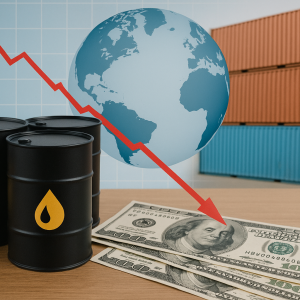Services up and industry stabilising, but rate cut postponed until June
Saturday 16 March 2024
Share on
Italy's growth slowed in early 2024: services moderating and industry stabilising. From Istat revision, Italian growth more robust in 2023 than previously estimated. Oil more expensive, inflation still high in the Eurozone, rate cut postponed to June. Domestic demand is expected to be weak and for goods exports the outlook is uncertain. Germany almost in recession, in the US industry is slowing down, while China is aiming high.
- Growth held back. The Italian economy is supported by low inflation, rising household confidence and growing services, while industry seems to be stabilising. There are, however, various negative factors: the brake on trade flows in the Suez Canal is continuing, oil prices are still rising, the rate cut is postponed again, and credit to businesses is still falling. A weak GDP is expected in Q1 2024.
- More expensive oil. Gas prices are on a slow downward path, although they remain high compared to pre-crisis levels (in March 26 €/mwh, from 35 at the end of 2023). Oil, on the other hand, continues to gradually increase in price (85 $/barrel, from 78), now at a historically high level: OECD crude oil stocks are in fact falling (-56 million barrels in February, from September 2023) because, while demand is being pulled by the emerging economies, supply is limited by declines in Opec and ex-USSR countries, despite the increase in the US.
- High inflation, rate cut postponed. Italian inflation remained low and stable in February (+0.8% per year), with energy prices (-17.3%) not affected so far by high oil prices and core inflation slowing (+2.2%). However, in the Eurozone average, although falling (+2.6% from +2.8%, with core at +3.1%), inflation remains above the ECB threshold of +2.0%. Moreover, one-year inflation expectations rose (2.4% in the eurozone, 2.5% in the US). Therefore, in March, the ECB left rates unchanged (4.50%) and the Fed is expected to do the same (5.50%). The markets moved the expectation of the first cut forward (June).
- Weak expected domestic demand. For consumption, more light: in January, retail sales fell slightly (-0.3%); there was a marginal drop in employment (-0.1%), but the medium-term trend remained very positive and supported incomes; household confidence rose again in February; rates and loans did not help. For investment, there are more shadows: credit is down (-4.0% per year in January); in February, business orders for capital goods are tapering off; business sentiment (IESI) is down.
- Moderately expanding services. In January, RTT (CSC-TeamSystem) indicated an increase in services (+1.1%). In February, the PMI confirmed that the sector returned to growth, moderately (52.2 from 51.2); business confidence, however, suffered a setback, after several months of recovery.
- Convalescent industry. RTT reports an increase in industry turnover in January (+3.2%), suggesting a recovery in production at the beginning of the year (-0.5% in Q4). In February, the HCOB PMI rose again slightly (48.7 from 48.5), but in the area of contraction, signalling that the decline in industry is easing; the CSC quick survey reinforces the expectation of a stabilisation in production; however, the decumulation of inventories continues and manufacturing business confidence falls again, to low levels.
- Germany: near-recession. Germany's GDP declined by -0.3% in Q4 2023, after two firm quarters. Demand is weak, both domestic due to the slump in investment (-1.9%), held back by the high cost of credit, and foreign (-1.6% export, down for over a year). German industry remains very contracted: -3.1% the gap in added value from pre-Covid; the picture for construction is heavier (-9.8%), penalised by adverse weather. Recent indicators do not signal any recovery: the decline in orders from manufacturing companies is steep (-29 the balance in January, from zero at the beginning of 2023).
- Export of goods: uncertain prospects. In Q4 2023, world trade increased (+0.5%), for the first time after four quarters of contraction (-1.9% for the year). But the difficulties of shipping (90% of global trade), and its costs, continue to fuel uncertainty. The Suez Canal, through which 15% of global goods pass, has reduced ship movements by about -40% (January-March 2024, in annual terms) and, in parallel, ship movements to the Cape of Good Hope have increased (+86%). Sea freight rates from Shanghai to Genoa are coming back from their late January peak, but remain very high (-30% the first seven days of March, after +218% on November 2023).
- USA: industry on the brakes. US industrial production in February rose slightly (+0.1%), but the change in Q1 2024 looms flat (after -0.6% in Q4 2023). In manufacturing, signs of weakness also seem to prevail among the indicators: the Chicago Purchasing Managers and PMI are confirmed to be in the recessionary zone (44.0 and 47.9), as opposed to the ISM alone (52.2). Conversely, new jobs created in February (275,000) were higher than the Q4 average (212,000).
- China is aiming high. For 2024, China sets its growth target at +5.0%, a realistic but challenging target as the post-pandemic rebound has faded. The determination to reach the target and counter the risks of a real estate crisis also shines through from the People's Bank of China's cut in five-year mortgage rates (-25 points instead of the expected 15). Meanwhile, economic indicators point to a continued, albeit marginal, improvement in Chinese manufacturing activity.
Focus of the month - Istat review shows stronger Italian growth
- ISTAT revisions. The dynamics of the economy in Italy are measured month by month by ISTAT, but the most recent data are 'provisional' and are then revised as more complete information becomes available to the Institute: for the National Accounts, the first releases are based on econometric estimates based on indicators, while more robust estimates are obtained, for example, when data on company balance sheets become available. Revisions have been quite extensive in recent years. This is also the case for the estimates published in March 2024, in particular for some variables (investment). To the point of changing the assessment of economic dynamics in the year just ended and in the one just begun.
- GDP 2023 higher. The quarterly profile of GDP (in constant prices) was revised upwards: the change for the whole of 2023 is +1.0% (+0.9% in the annual data), much higher than the end-January ISTAT estimate (+0.7%, preliminary estimate). The 1st quarter was revised downwards by -0.1%, but the 2nd quarter was revised upwards by +0.2% and the 3rd quarter by +0.1% (and also the 4th quarter of 2022 by +0.2%). Thus, the annual change for 2023 already 'captured' in Q3 is up by 3 tenths compared to January's figures (from +0.7%, to +1.0%), which is a very marked revision given the low starting pace of growth. The drag to 2024 also rose, from +0.1% to +0.2%.
- Investments: they did not fall but grew. The biggest change is in fixed investments: with the updated data, no more reductions can be seen during 2023; the worst figure is the flat Q2, whereas Q1 now shows strong growth. In the previously released data (December 2023), by contrast, Q1 was weak, there was a slump in Q2 and a small decline in Q3 as well. In addition, there was an unexpected jump in the 4th. As a result, investment growth in 2023 is now +4.9% (of which +4.2% acquired in the 3rd), whereas before the revision the change acquired in the 3rd was +0.4%. Thus, from near stagnation to strong expansion.
- More private and public consumption. On household consumption the revision was smaller, but still significant: +0.2% per quarter in the first half of 2023, especially relevant for the 2nd, which in the data before the revision had a flat dynamic. In this case, the change acquired in the 3rd is unchanged, because ISTAT also revised the dynamics in 2022 to the same extent and in the opposite direction. PA consumption has also been revised upwards in 2023, much more than private consumption: on average, +0.3% per quarter in the first 3; the acquired change to Q3 has risen from -0.4% to +1.1%, with the whole of 2023 recording +1.2%. Thus, we went from a small decrease in public spending to a sharp increase.
- Strong stock decumulation. Against higher investment (+0.8 the largest contribution to GDP, in the first 3 quarters) and also total consumption (+0.4), the revision lowered the dynamics of inventories (-1.0) a lot.
- Labour and deficits were also reviewed. The Istat revision also involves other key economic variables. Full-time equivalent Labour Units (FTE) now show a higher dynamic in 2023 (+2.2% per year): in particular, they grow by +0.2% per quarter in the first 3 quarters compared to the old data. The PA deficit in 2023 is estimated to be larger: 7.2% of GDP, up from 5.3% forecast by the government in September, due to the strong increase in capital expenditure related to tax credits (Superbonus, Transition 4.0).
- Better prospects on 2024. If last year the Italian economy grew by 1.0%, a much higher pace than we were used to in pre-Covid, despite the ECB tightening, and also thanks to the PNRR, the forecasts for 2024, so far modest (the last Consensus indicated +0.7% for GDP), can only be more positive, also because rates are expected to fall and the PNRR to accelerate.
- Does this also happen in other countries? Eurostat data, collecting national statistics, incorporate revisions of individual EU countries, which are no less than those of Italy. In France, for example, the update shows a lower profile for private investment and consumption, higher for public consumption. In Spain, strong rise in public spending, fall in investments. These are uncertain times for the economy, difficult for economists.






















